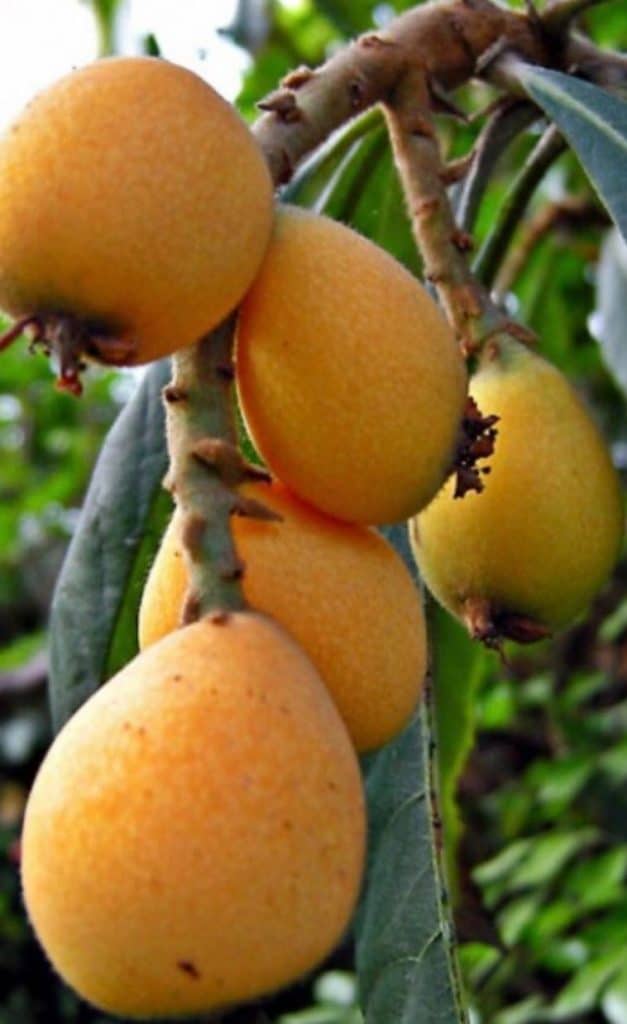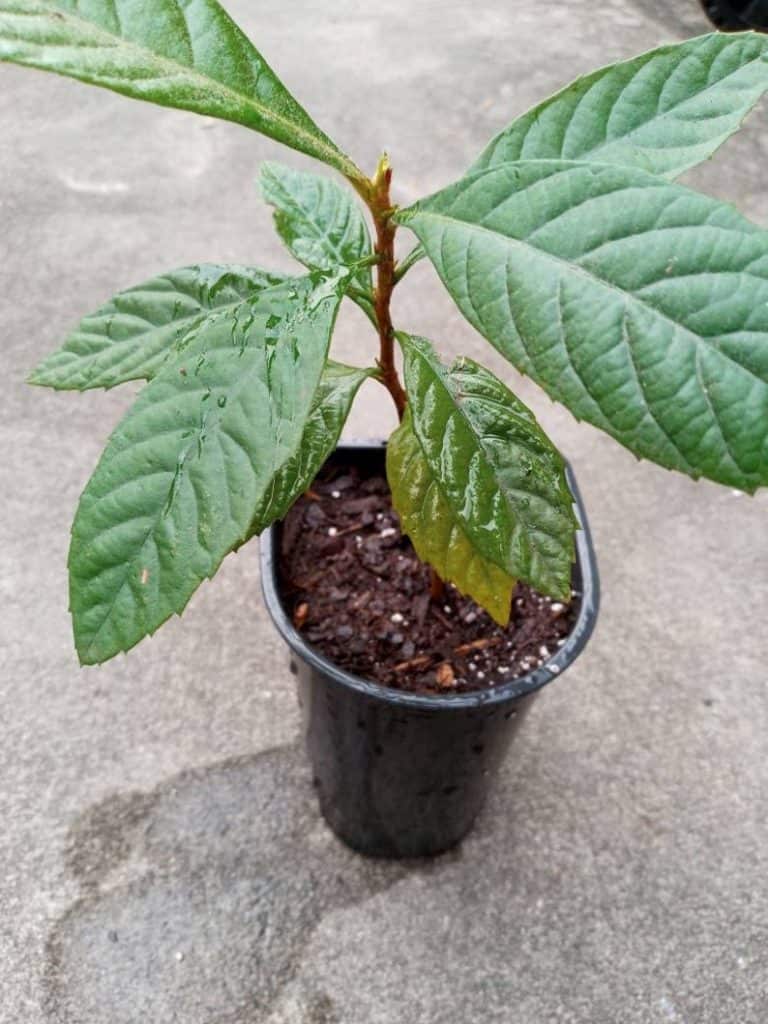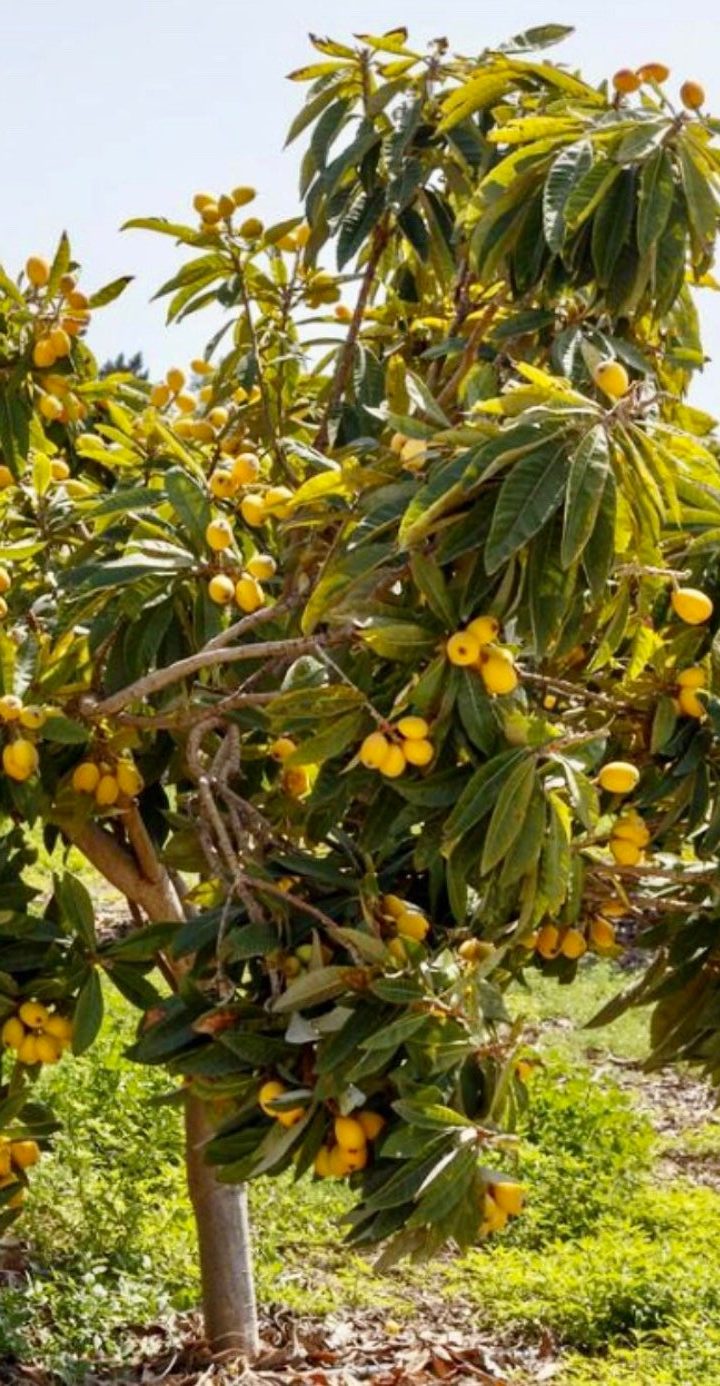The loquat tree, also known as Erioboytra japonica, produces juicy, sweet, tangy plum-sized fruits with a yellow or orange thin downy skin. Depending on the cultivar, their flesh can be white, orange, or yellow.
The fruit is delicious, whether fresh or dried. It can be added to fruit salads or fruit caps or cooked and preserved. They also make excellent pies, preserves, and jams.
It’s possible to grow a loquat tree in a pot. They also grow well in the ground.
Planting trees is expensive. You’ll want to be sure they grow. We explain loquat tree care so you can grow these delicious fruit at home.
Loquat Tree
Loquat trees are broad-leaf evergreen trees. They like the sun, but they can tolerate partial shade. They don’t do well in cold weather as it damages the fruit and flowers.
In terms of the soil, loquats thrive in alkaline soils with good drainage and moderate fertility.
Mediterranean climate is perfect for loquat trees, and in the US, the tree is best suited for the USDA plant hardiness zones 8 through 11.
You can find a loquat tree for sale at garden centers in nurseries if you live in these climate zones.
Other names are Japanese plum, Japanese Medlar, and Chinese plum. The fruits are round or oval and have orange, yellow, or white flesh.
Loquat Pollination
Some loquat cultivars are self-pollinating, meaning they can produce fruit on their own as they have both female and male flower parts..
However, most loquat trees are partially self-pollinating. These are capable of producing fruit on their own, but they’re most productive when paired with another tree.
Therefore, for optimum yield, plant two trees near each other. That way, you’re assured of pollination. The next year, you may decide to add more.

How Long Until a Loquat Tree Starts Fruiting
Loquat trees start producing flowers toward the end of the summer. These form on the tips of branches younger than six months. Bees and other insects will help with pollination, and soon individual flowers will form fruits.
Loquat fruits take about 90 days to mature after the flower opens fully.
This fruit tree is hardy and can withstand cold temperatures. However, while they are cold hardy to 10 degrees F, a cold snap at the start or end of the fall season can cause young fruit to fall off.
Cover the trees to keep them warm when the temperature is expected to drop to 27 degrees F or lower.
When the fall arrives, you may consider covering the tree with a burlap net. You can also cover the surrounding ground at the base with mulch or burlap to keep your tree and roots warm.
Sometimes a loquat may have no fruit and that’s often due to improper planting.
When to Harvest Loquat
Before harvesting, make sure the fruits have ripened fully on the tree. How do you know it’s ripe enough for harvesting? The fruit will appear yellow-orange and feels soft. It’ll also be easy to pull off the stem.
Loquat fruits mature three months after the flower fully opens.
Bear in mind fallen loquat fruits are messy. They also drop leaves. Therefore, save yourself from such a mess by harvesting them as soon as they’re ready. It will also mean you will attract less pests.
Mature loquat trees yield a lot of fruit. You can expect over 30 pounds of fruit. Some will bear one hundred pounds or more.
Loquat Fruit
Loquats are slightly tart and taste a little like citrus fruits. They are small like kumquats. You can eat loquats raw, including their skin.
As far as loquat recipes, loquat jam is popular. You can also eat loquats right off the tree. Just be sure to spit out the seeds.
Do not eat loquat seeds. They are hard, large, and bitter.

How to Grow a Loquat Tree
These trees grow well in pots, making them ideal for a small backyard or patio.
Here’s a step-by-step guide on how to grow a loquat tree in a container:
- Choose a container at least 24 inches wide and position it under full sun.
- Fill the pot with quality potting soil mix.
- Carefully remove the shrub from the container, keeping the root ball intact.
- Position your shrub in the pot and backfill with potting mix, firming it down gently.
- Only fill with new soil to the top of the root ball. Do not cover the top of the root ball with additional soil.
- Slowly water around the plant. Try to soak the root ball without watering the trunk.
- In the first year, water daily or every other day, preferably in the evening. Once established, water deeply once a week.
Tips for Growing Loquat in Container
Drainage
When choosing to grow loquat in a pot, remember this will be it’s home. Be sure there are enough drainage holes. You can line with holes with a paper coffee filter so dirt doesn’t escape.
If possible, it’s good to raise the pots up so there is air circulation under the holes. Loquat trees like water but can’t tolerate roots being wet which can cause root rot.
You can put the pot on a rolling container or other platform. If you can’t do that, you can move the pot so the ground underneath gets a chance to dry. No matter what, just be sure there are enough holes for water to drain out.
Ability to Move or Cover the Trees
If you plant loquat trees in large plastic planters instead of ceramic or heavier materials, you can move the pots as needed.
Keep this in mind for cold seasons, when you may need to reposition them so they will be warmer.
Also keep in mind the hot afternoon sun at the peak of summer. You may need to move them to a shaded area where they’ll still enjoy full morning and early afternoon sun.
Get the Best Soil You Can Afford
In addition to having the cost of the loquat tree and the container, you’ll need to consider the soil.
While it may seem a simple thing, and yes, it will add to the cost, but you want to do all you can to ensure the tree grows. From a nursery a small loquat tree can cost $60. Larger ones can be up to $100.
Well-draining, nutrient-rich soil will help the loquat thrive.
Therefore, it’s important to get the most high-quality soil you can afford. Go to a nursery or garden soil if possible and have them direct you to the best soil for sub-tropical fruits or citrus trees.
We use Fox Farm Ocean Floor Soil for our fruit trees in containers. You can usually find it at nurseries and garden centers and sometimes at home improvement stores.
What’s good about this soil is that it’s designed for container gardening and it’s ready to use out of the bag without adding compost or anything else. It contains fish emulsion, bat guano, sphagnum peat moss, crab meal, and more.
It’s light and aerated soil which is what you want when planting loquat trees.
No matter what soil you use, choose one that’s designed for containers to ensure it has all the necessary nutrients.
Planting Root Ball
Whether you are transplanting loquat tree in the ground or a pot, be very careful. It’s best to have two people so one person can hold the container and the other can support the tree as you loosen it from it’s container.
Be very careful when taking the loquat tree out of the original planter and putting it into a larger pot or in the ground.
Do not tease the roots or cut away any tangled or circled roots. Keep the root ball intact and place it in the ground or pot.
Also, fill with additional soil only to the line of the root ball. Don’t cover the top of it with new soil.
Loquat Tree Care
If you’re growing the tree in a windy area, erect a windbreak to protect your young tree. Once the tree is a few years old and well established, you’ll not need the windbreak anymore as the tree will be firmly rooted.
Here’s how to care for a loquat tree:
Watering
It’s best to plant loquat where it will be convenient for you to water it everyday and then weekly once it’s established.
If possible, set it up on irrigation with a timer. They will do well with a slow drip once per day in the evening until established.
The loquat tree is drought-resistant. Nevertheless, regularly watering it will make it more productive and the fruits will be juicy.
However, ensure you don’t overwater as if the soil is permanently wet, it will kill the plant. The soil should be evenly moist, not wet throughout.
Remember to also water during harvest time.
Mulching
When caring for a loquat tree, consider mulching.
You may want to spread organic mulch such as sugarcane or pea straw, or bark chips around the base. If you do this, make it a light layer, not thick. Apply it as the weather gets hot.
Mulching will help the soil retain moisture in the hot months. It will also help keep the roots cooler. In the cold months, it can keep the roots warm.
If you choose to add mulch, be absolutely sure none of it touches the trunk. Apply it at the tree’s base in a ring, keeping it about 6 – 10 inches away from the trunk and make it about 3 inches wide.
Watch for signs of rotting. If so, remove it. Let it area dry out.
Fertilizing
Being a hardy tree, not using fertilizer may not interfere with its growth in any way. However, a newly planted shrub requires fertilizing a month after planting.
Once your tree is about 8 feet tall, you can top dress it with a general-purpose fertilizer like 6-6-6, suitable for young and mature loquat trees.
Applying the fertilizer three times per year (in spring, winter, and autumn) over the growing season will make the tree more fruitful.
Be sure to avoid fertilizers with a high nitrogen content as these reduce flowering. Also, look out for signs of excessive growth and limit fertilizing to once a year, ideally in midwinter.
How to Prune a Loquat Tree
Pruning is vital for helping the tree sprout more lateral buds the following spring and preventing dead panicles from consuming the tree’s energy. It also ensures ripening fruit can benefit from much needed sunlight.
For loquat trees, pruning should be done after harvest, preferably during late winter.
If container gardening, in the tree’s first two years, prune the tips to encourage branching. Prune back the tree’s shoots so that they don’t grow too tall. Also prune out the dead, diseased, and crossing branches and remove dense shoots
Pests to Loquat Tree
Although loquat trees are majorly pest-free, again, thanks to their hardiness, the black scale may attack your tree. If that should happen, blast it off with water or use a neem oil treatment.
Drying winds can result in leaf scorch. If you live in a humid area, beware of fire blight which often poses problems in such conditions. Codling moths and carpenter bees are other insects to be aware of.
How to Grow Loquat Tree from a Seed
It’s possible to grow a loquat tree from seed. However, these trees grow at a moderate pace; they are not fast-growing trees. It may be more advantageous to buy a sapling or grafted seedling. You can find loquat trees for sale at nurseries.
However, you can purchase loquat tree seeds at garden centers if they will grow in your hardiness zone.
Plant in a pot with nutritious soil. Water regularly and be sure to set it in a sunny area in your home. Loquat seeds germinate easily. However, it will take several years for the tree to bear fruit.
Loquat Tree Lifespan
Loquat trees live to 20 or 30 years, and during this lifespan, it grows 15 to 30 feet tall. When the tree hits ten years, it will be 12 to 15 feet tall.
The dwarf cultivar, which is the ideal type to plant in a pot, grows to about half the standard size of a regular tree.
Conclusion
Now you understand more about the loquat tree, including where to grow it, how to care for loquat trees, fruiting, harvesting, and eating. If you live in a climate to support it’s growth, planting a loquat will provide you with ripe and tasty fruits.
It’s a great tree to add to a backyard orchard or garden to grow fruits at home. This will enable you to be more sustainable. It’s also fun to pick the fruits and like most fruit, they have lots of health benefits.
The loquat tree will produce delicious fruits. Loquat trees can grow in the ground or in containers. This makes them convenient to grow on a patio garden or small backyard.
Other fruit trees to grow with loquats are pepino melon and orange trees and a pomegranate tree.

